Organizational Behavior: Motivation, Leadership, and Tesco Analysis
VerifiedAdded on 2020/10/05
|15
|3604
|356
Report
AI Summary
This report delves into the realm of organizational behavior, focusing on the critical aspects of motivation, leadership, and individual performance, with a specific case study on Tesco. It begins by exploring various motivation theories, including Maslow's hierarchy of needs and Herzberg's two-factor theory, detailing their application and implications within an organizational context. The report then compares and contrasts different management and leadership styles, such as directive, authoritative, democratic, and laissez-faire, assessing their respective advantages and disadvantages. Furthermore, it identifies and analyzes factors influencing individual behavior within Tesco, providing a holistic view of how these elements interact to shape employee performance and organizational success. The analysis aims to offer practical insights into how organizations can enhance employee motivation, adopt effective leadership strategies, and foster a positive work environment.
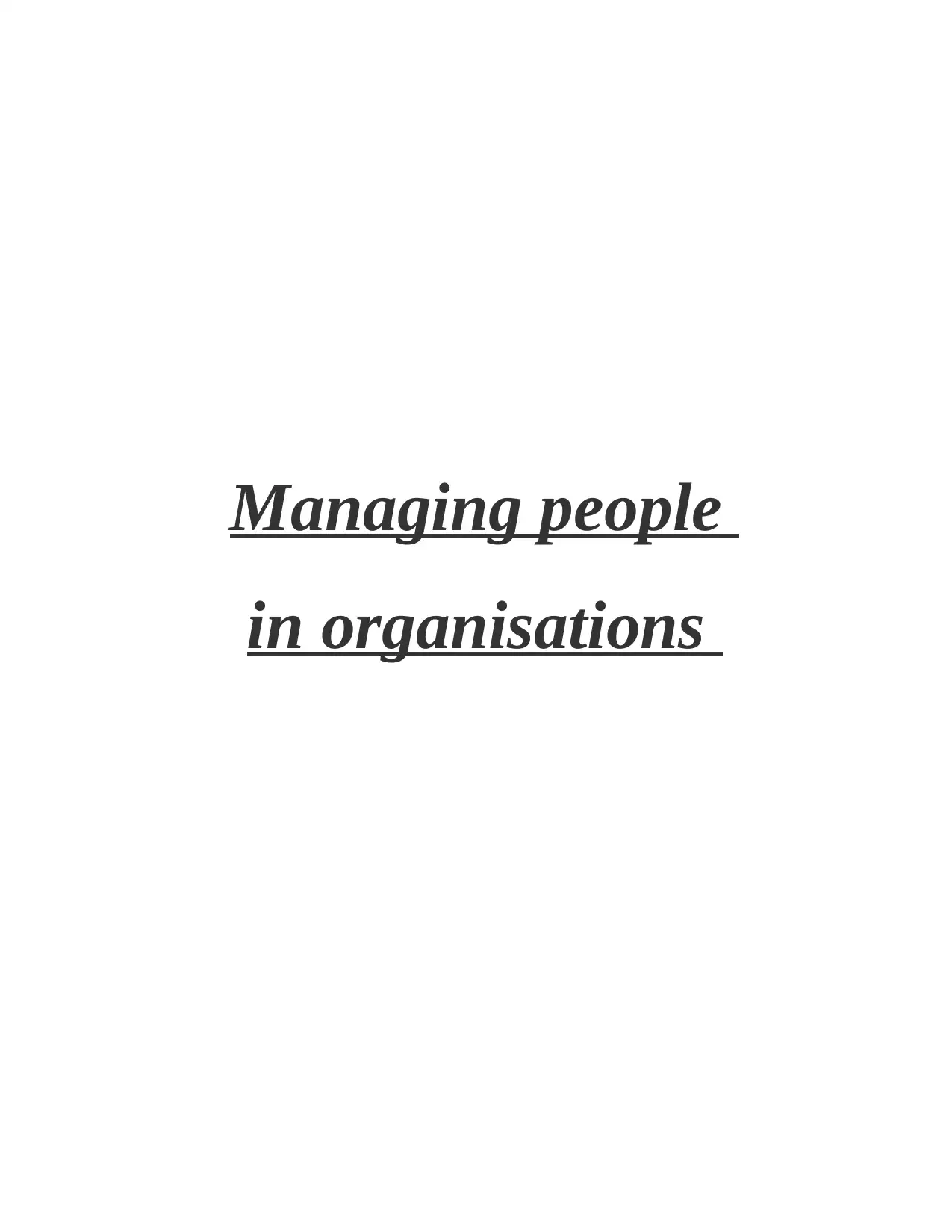
Managing people
in organisations
in organisations
Paraphrase This Document
Need a fresh take? Get an instant paraphrase of this document with our AI Paraphraser
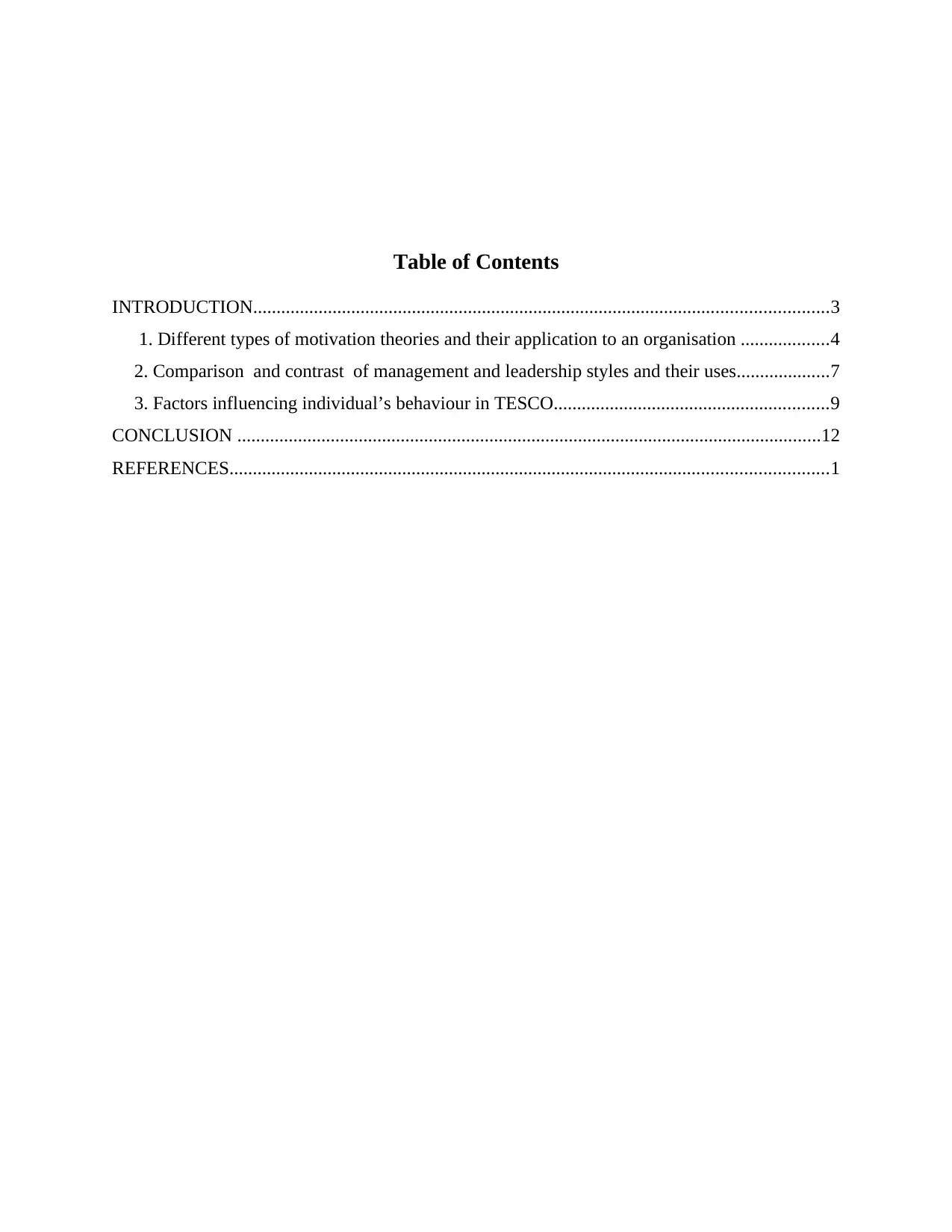
Table of Contents
INTRODUCTION...........................................................................................................................3
1. Different types of motivation theories and their application to an organisation ...................4
2. Comparison and contrast of management and leadership styles and their uses....................7
3. Factors influencing individual’s behaviour in TESCO...........................................................9
CONCLUSION .............................................................................................................................12
REFERENCES................................................................................................................................1
INTRODUCTION...........................................................................................................................3
1. Different types of motivation theories and their application to an organisation ...................4
2. Comparison and contrast of management and leadership styles and their uses....................7
3. Factors influencing individual’s behaviour in TESCO...........................................................9
CONCLUSION .............................................................................................................................12
REFERENCES................................................................................................................................1
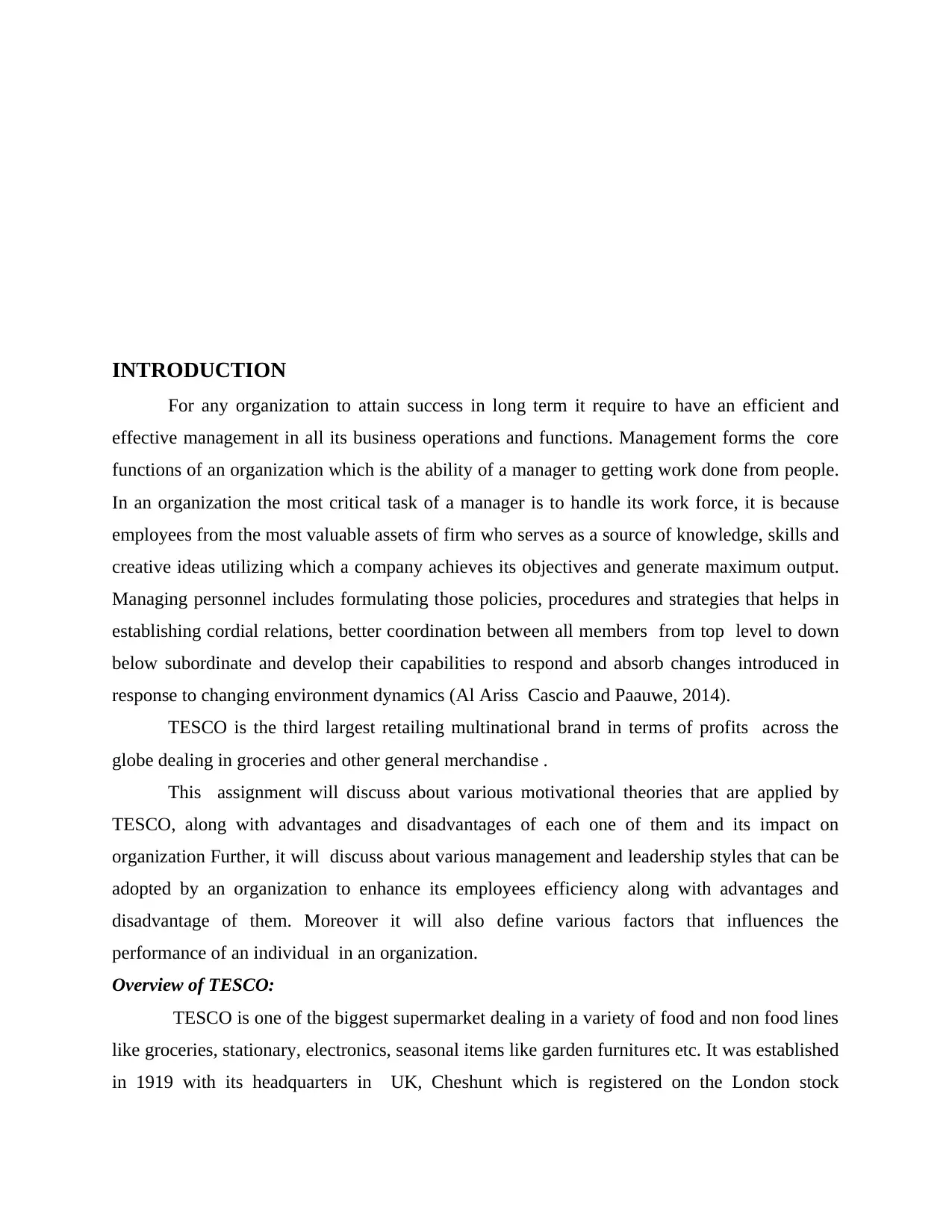
INTRODUCTION
For any organization to attain success in long term it require to have an efficient and
effective management in all its business operations and functions. Management forms the core
functions of an organization which is the ability of a manager to getting work done from people.
In an organization the most critical task of a manager is to handle its work force, it is because
employees from the most valuable assets of firm who serves as a source of knowledge, skills and
creative ideas utilizing which a company achieves its objectives and generate maximum output.
Managing personnel includes formulating those policies, procedures and strategies that helps in
establishing cordial relations, better coordination between all members from top level to down
below subordinate and develop their capabilities to respond and absorb changes introduced in
response to changing environment dynamics (Al Ariss Cascio and Paauwe, 2014).
TESCO is the third largest retailing multinational brand in terms of profits across the
globe dealing in groceries and other general merchandise .
This assignment will discuss about various motivational theories that are applied by
TESCO, along with advantages and disadvantages of each one of them and its impact on
organization Further, it will discuss about various management and leadership styles that can be
adopted by an organization to enhance its employees efficiency along with advantages and
disadvantage of them. Moreover it will also define various factors that influences the
performance of an individual in an organization.
Overview of TESCO:
TESCO is one of the biggest supermarket dealing in a variety of food and non food lines
like groceries, stationary, electronics, seasonal items like garden furnitures etc. It was established
in 1919 with its headquarters in UK, Cheshunt which is registered on the London stock
For any organization to attain success in long term it require to have an efficient and
effective management in all its business operations and functions. Management forms the core
functions of an organization which is the ability of a manager to getting work done from people.
In an organization the most critical task of a manager is to handle its work force, it is because
employees from the most valuable assets of firm who serves as a source of knowledge, skills and
creative ideas utilizing which a company achieves its objectives and generate maximum output.
Managing personnel includes formulating those policies, procedures and strategies that helps in
establishing cordial relations, better coordination between all members from top level to down
below subordinate and develop their capabilities to respond and absorb changes introduced in
response to changing environment dynamics (Al Ariss Cascio and Paauwe, 2014).
TESCO is the third largest retailing multinational brand in terms of profits across the
globe dealing in groceries and other general merchandise .
This assignment will discuss about various motivational theories that are applied by
TESCO, along with advantages and disadvantages of each one of them and its impact on
organization Further, it will discuss about various management and leadership styles that can be
adopted by an organization to enhance its employees efficiency along with advantages and
disadvantage of them. Moreover it will also define various factors that influences the
performance of an individual in an organization.
Overview of TESCO:
TESCO is one of the biggest supermarket dealing in a variety of food and non food lines
like groceries, stationary, electronics, seasonal items like garden furnitures etc. It was established
in 1919 with its headquarters in UK, Cheshunt which is registered on the London stock
⊘ This is a preview!⊘
Do you want full access?
Subscribe today to unlock all pages.

Trusted by 1+ million students worldwide
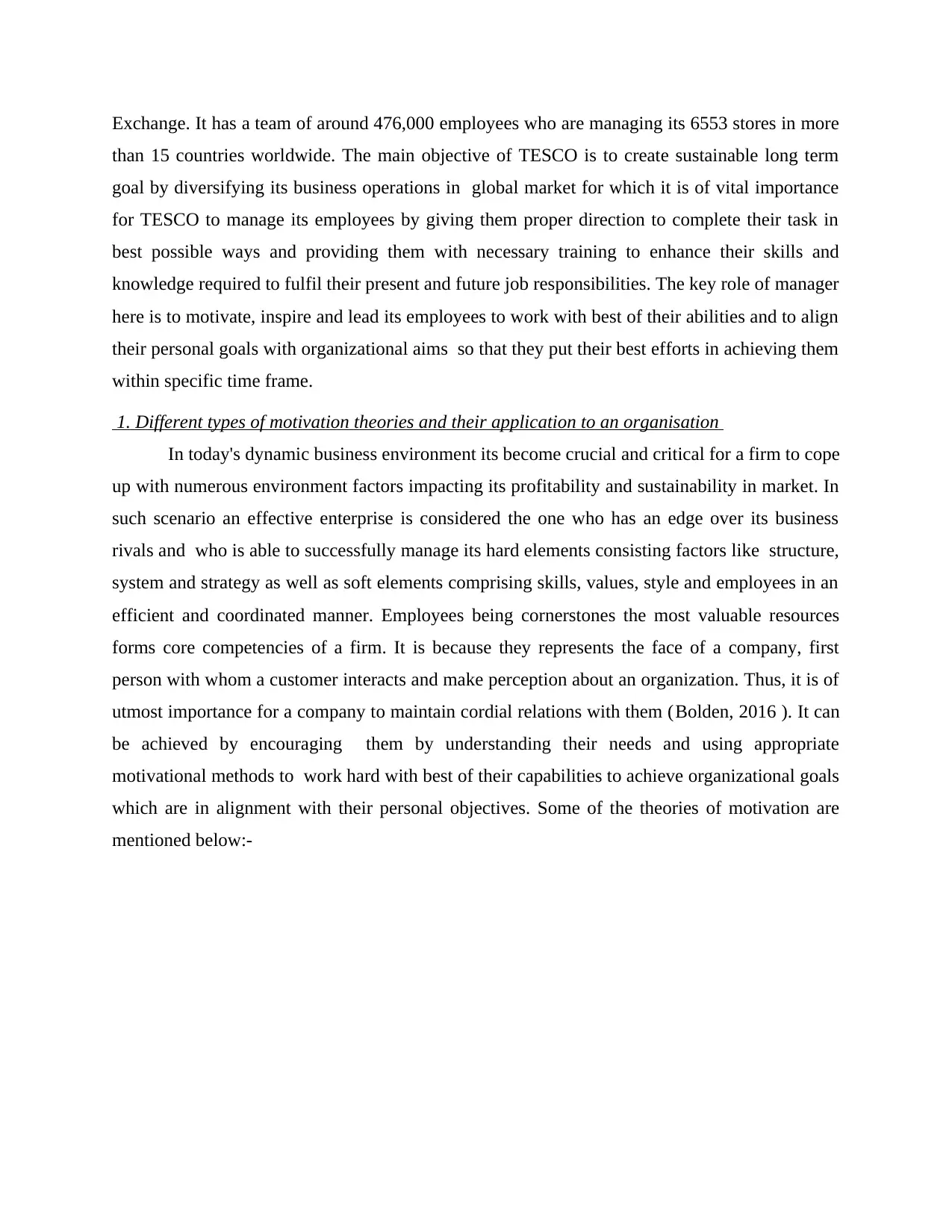
Exchange. It has a team of around 476,000 employees who are managing its 6553 stores in more
than 15 countries worldwide. The main objective of TESCO is to create sustainable long term
goal by diversifying its business operations in global market for which it is of vital importance
for TESCO to manage its employees by giving them proper direction to complete their task in
best possible ways and providing them with necessary training to enhance their skills and
knowledge required to fulfil their present and future job responsibilities. The key role of manager
here is to motivate, inspire and lead its employees to work with best of their abilities and to align
their personal goals with organizational aims so that they put their best efforts in achieving them
within specific time frame.
1. Different types of motivation theories and their application to an organisation
In today's dynamic business environment its become crucial and critical for a firm to cope
up with numerous environment factors impacting its profitability and sustainability in market. In
such scenario an effective enterprise is considered the one who has an edge over its business
rivals and who is able to successfully manage its hard elements consisting factors like structure,
system and strategy as well as soft elements comprising skills, values, style and employees in an
efficient and coordinated manner. Employees being cornerstones the most valuable resources
forms core competencies of a firm. It is because they represents the face of a company, first
person with whom a customer interacts and make perception about an organization. Thus, it is of
utmost importance for a company to maintain cordial relations with them (Bolden, 2016 ). It can
be achieved by encouraging them by understanding their needs and using appropriate
motivational methods to work hard with best of their capabilities to achieve organizational goals
which are in alignment with their personal objectives. Some of the theories of motivation are
mentioned below:-
than 15 countries worldwide. The main objective of TESCO is to create sustainable long term
goal by diversifying its business operations in global market for which it is of vital importance
for TESCO to manage its employees by giving them proper direction to complete their task in
best possible ways and providing them with necessary training to enhance their skills and
knowledge required to fulfil their present and future job responsibilities. The key role of manager
here is to motivate, inspire and lead its employees to work with best of their abilities and to align
their personal goals with organizational aims so that they put their best efforts in achieving them
within specific time frame.
1. Different types of motivation theories and their application to an organisation
In today's dynamic business environment its become crucial and critical for a firm to cope
up with numerous environment factors impacting its profitability and sustainability in market. In
such scenario an effective enterprise is considered the one who has an edge over its business
rivals and who is able to successfully manage its hard elements consisting factors like structure,
system and strategy as well as soft elements comprising skills, values, style and employees in an
efficient and coordinated manner. Employees being cornerstones the most valuable resources
forms core competencies of a firm. It is because they represents the face of a company, first
person with whom a customer interacts and make perception about an organization. Thus, it is of
utmost importance for a company to maintain cordial relations with them (Bolden, 2016 ). It can
be achieved by encouraging them by understanding their needs and using appropriate
motivational methods to work hard with best of their capabilities to achieve organizational goals
which are in alignment with their personal objectives. Some of the theories of motivation are
mentioned below:-
Paraphrase This Document
Need a fresh take? Get an instant paraphrase of this document with our AI Paraphraser
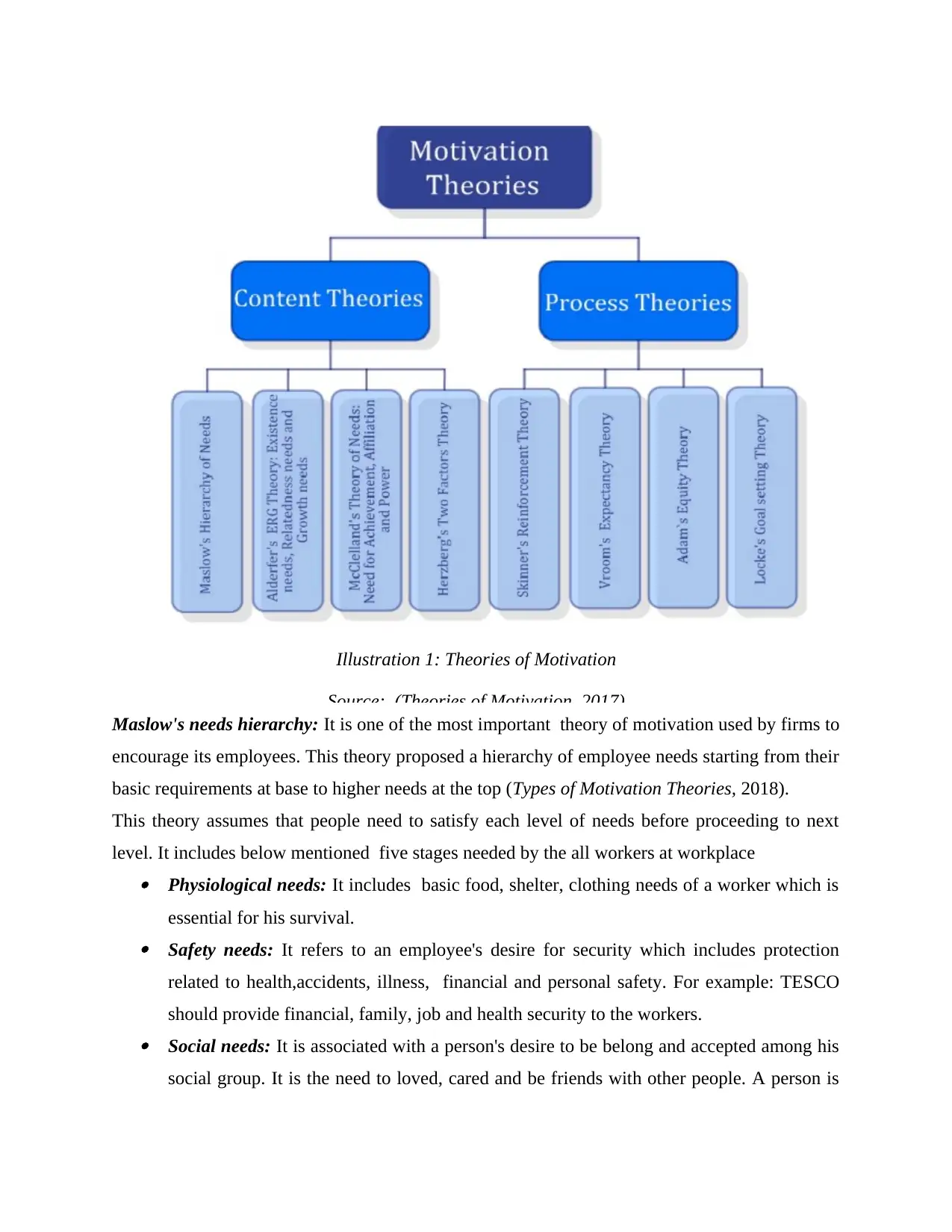
Maslow's needs hierarchy: It is one of the most important theory of motivation used by firms to
encourage its employees. This theory proposed a hierarchy of employee needs starting from their
basic requirements at base to higher needs at the top (Types of Motivation Theories, 2018).
This theory assumes that people need to satisfy each level of needs before proceeding to next
level. It includes below mentioned five stages needed by the all workers at workplace Physiological needs: It includes basic food, shelter, clothing needs of a worker which is
essential for his survival. Safety needs: It refers to an employee's desire for security which includes protection
related to health,accidents, illness, financial and personal safety. For example: TESCO
should provide financial, family, job and health security to the workers. Social needs: It is associated with a person's desire to be belong and accepted among his
social group. It is the need to loved, cared and be friends with other people. A person is
Illustration 1: Theories of Motivation
Source: (Theories of Motivation, 2017)
encourage its employees. This theory proposed a hierarchy of employee needs starting from their
basic requirements at base to higher needs at the top (Types of Motivation Theories, 2018).
This theory assumes that people need to satisfy each level of needs before proceeding to next
level. It includes below mentioned five stages needed by the all workers at workplace Physiological needs: It includes basic food, shelter, clothing needs of a worker which is
essential for his survival. Safety needs: It refers to an employee's desire for security which includes protection
related to health,accidents, illness, financial and personal safety. For example: TESCO
should provide financial, family, job and health security to the workers. Social needs: It is associated with a person's desire to be belong and accepted among his
social group. It is the need to loved, cared and be friends with other people. A person is
Illustration 1: Theories of Motivation
Source: (Theories of Motivation, 2017)
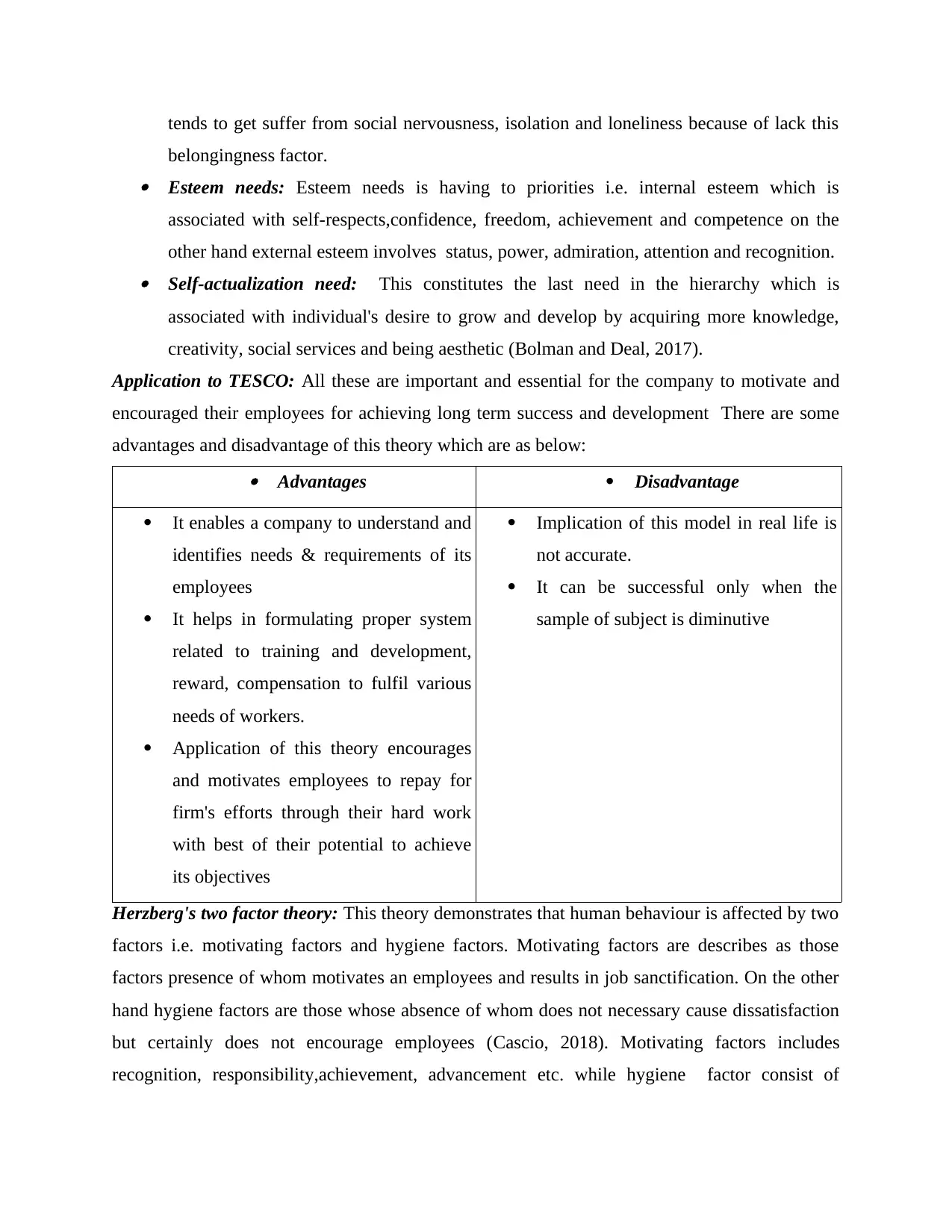
tends to get suffer from social nervousness, isolation and loneliness because of lack this
belongingness factor. Esteem needs: Esteem needs is having to priorities i.e. internal esteem which is
associated with self-respects,confidence, freedom, achievement and competence on the
other hand external esteem involves status, power, admiration, attention and recognition. Self-actualization need: This constitutes the last need in the hierarchy which is
associated with individual's desire to grow and develop by acquiring more knowledge,
creativity, social services and being aesthetic (Bolman and Deal, 2017).
Application to TESCO: All these are important and essential for the company to motivate and
encouraged their employees for achieving long term success and development There are some
advantages and disadvantage of this theory which are as below:
Advantages Disadvantage
It enables a company to understand and
identifies needs & requirements of its
employees
It helps in formulating proper system
related to training and development,
reward, compensation to fulfil various
needs of workers.
Application of this theory encourages
and motivates employees to repay for
firm's efforts through their hard work
with best of their potential to achieve
its objectives
Implication of this model in real life is
not accurate.
It can be successful only when the
sample of subject is diminutive
Herzberg's two factor theory: This theory demonstrates that human behaviour is affected by two
factors i.e. motivating factors and hygiene factors. Motivating factors are describes as those
factors presence of whom motivates an employees and results in job sanctification. On the other
hand hygiene factors are those whose absence of whom does not necessary cause dissatisfaction
but certainly does not encourage employees (Cascio, 2018). Motivating factors includes
recognition, responsibility,achievement, advancement etc. while hygiene factor consist of
belongingness factor. Esteem needs: Esteem needs is having to priorities i.e. internal esteem which is
associated with self-respects,confidence, freedom, achievement and competence on the
other hand external esteem involves status, power, admiration, attention and recognition. Self-actualization need: This constitutes the last need in the hierarchy which is
associated with individual's desire to grow and develop by acquiring more knowledge,
creativity, social services and being aesthetic (Bolman and Deal, 2017).
Application to TESCO: All these are important and essential for the company to motivate and
encouraged their employees for achieving long term success and development There are some
advantages and disadvantage of this theory which are as below:
Advantages Disadvantage
It enables a company to understand and
identifies needs & requirements of its
employees
It helps in formulating proper system
related to training and development,
reward, compensation to fulfil various
needs of workers.
Application of this theory encourages
and motivates employees to repay for
firm's efforts through their hard work
with best of their potential to achieve
its objectives
Implication of this model in real life is
not accurate.
It can be successful only when the
sample of subject is diminutive
Herzberg's two factor theory: This theory demonstrates that human behaviour is affected by two
factors i.e. motivating factors and hygiene factors. Motivating factors are describes as those
factors presence of whom motivates an employees and results in job sanctification. On the other
hand hygiene factors are those whose absence of whom does not necessary cause dissatisfaction
but certainly does not encourage employees (Cascio, 2018). Motivating factors includes
recognition, responsibility,achievement, advancement etc. while hygiene factor consist of
⊘ This is a preview!⊘
Do you want full access?
Subscribe today to unlock all pages.

Trusted by 1+ million students worldwide
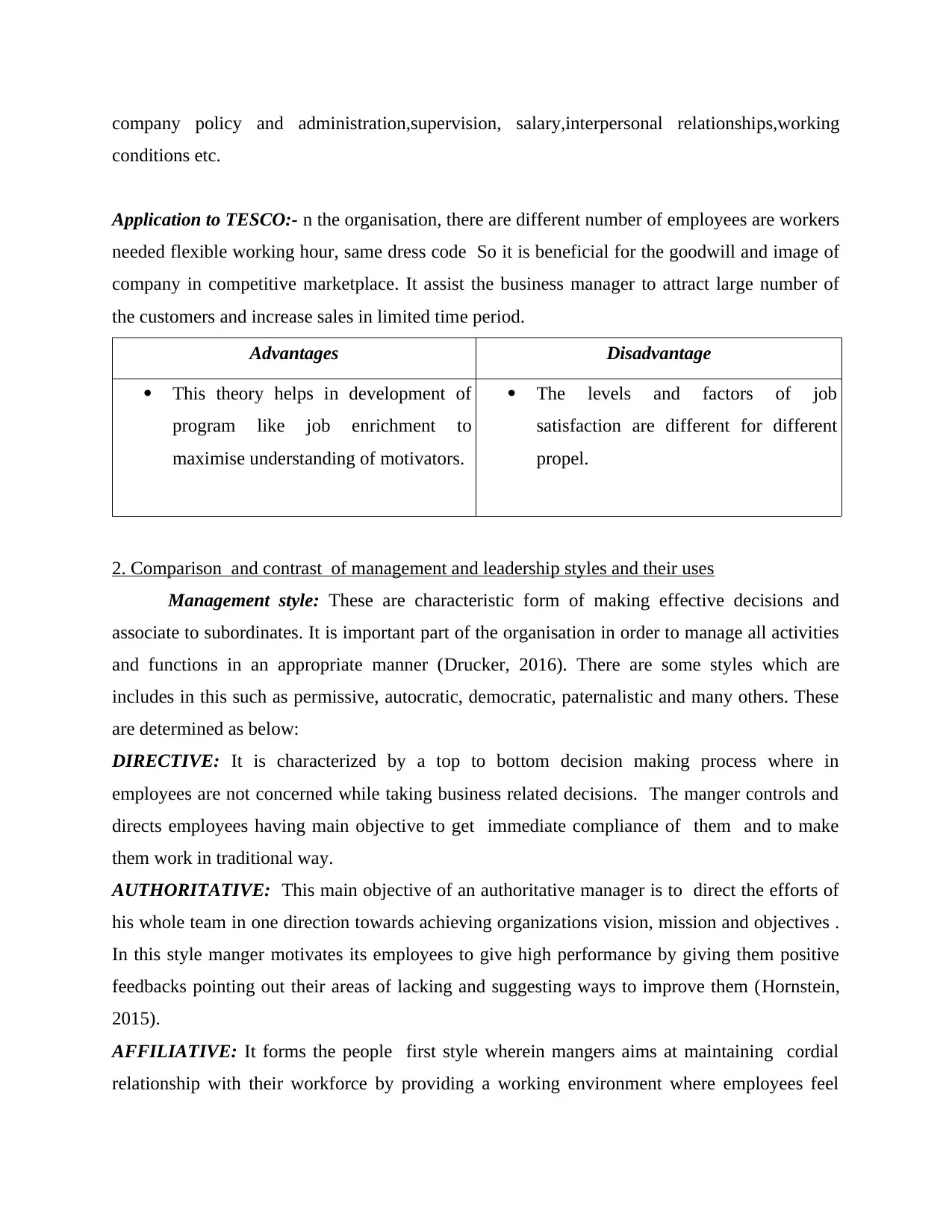
company policy and administration,supervision, salary,interpersonal relationships,working
conditions etc.
Application to TESCO:- n the organisation, there are different number of employees are workers
needed flexible working hour, same dress code So it is beneficial for the goodwill and image of
company in competitive marketplace. It assist the business manager to attract large number of
the customers and increase sales in limited time period.
Advantages Disadvantage
This theory helps in development of
program like job enrichment to
maximise understanding of motivators.
The levels and factors of job
satisfaction are different for different
propel.
2. Comparison and contrast of management and leadership styles and their uses
Management style: These are characteristic form of making effective decisions and
associate to subordinates. It is important part of the organisation in order to manage all activities
and functions in an appropriate manner (Drucker, 2016). There are some styles which are
includes in this such as permissive, autocratic, democratic, paternalistic and many others. These
are determined as below:
DIRECTIVE: It is characterized by a top to bottom decision making process where in
employees are not concerned while taking business related decisions. The manger controls and
directs employees having main objective to get immediate compliance of them and to make
them work in traditional way.
AUTHORITATIVE: This main objective of an authoritative manager is to direct the efforts of
his whole team in one direction towards achieving organizations vision, mission and objectives .
In this style manger motivates its employees to give high performance by giving them positive
feedbacks pointing out their areas of lacking and suggesting ways to improve them (Hornstein,
2015).
AFFILIATIVE: It forms the people first style wherein mangers aims at maintaining cordial
relationship with their workforce by providing a working environment where employees feel
conditions etc.
Application to TESCO:- n the organisation, there are different number of employees are workers
needed flexible working hour, same dress code So it is beneficial for the goodwill and image of
company in competitive marketplace. It assist the business manager to attract large number of
the customers and increase sales in limited time period.
Advantages Disadvantage
This theory helps in development of
program like job enrichment to
maximise understanding of motivators.
The levels and factors of job
satisfaction are different for different
propel.
2. Comparison and contrast of management and leadership styles and their uses
Management style: These are characteristic form of making effective decisions and
associate to subordinates. It is important part of the organisation in order to manage all activities
and functions in an appropriate manner (Drucker, 2016). There are some styles which are
includes in this such as permissive, autocratic, democratic, paternalistic and many others. These
are determined as below:
DIRECTIVE: It is characterized by a top to bottom decision making process where in
employees are not concerned while taking business related decisions. The manger controls and
directs employees having main objective to get immediate compliance of them and to make
them work in traditional way.
AUTHORITATIVE: This main objective of an authoritative manager is to direct the efforts of
his whole team in one direction towards achieving organizations vision, mission and objectives .
In this style manger motivates its employees to give high performance by giving them positive
feedbacks pointing out their areas of lacking and suggesting ways to improve them (Hornstein,
2015).
AFFILIATIVE: It forms the people first style wherein mangers aims at maintaining cordial
relationship with their workforce by providing a working environment where employees feel
Paraphrase This Document
Need a fresh take? Get an instant paraphrase of this document with our AI Paraphraser
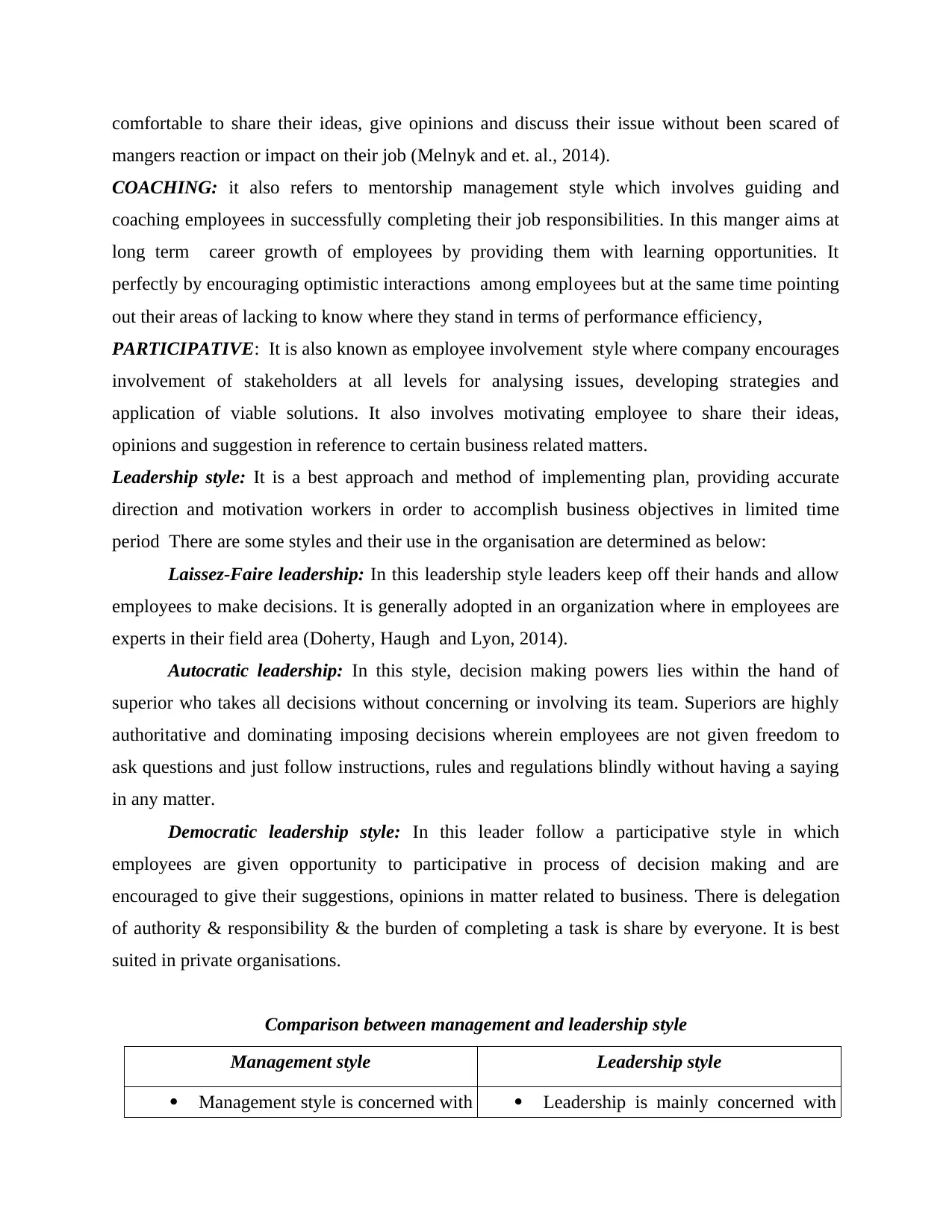
comfortable to share their ideas, give opinions and discuss their issue without been scared of
mangers reaction or impact on their job (Melnyk and et. al., 2014).
COACHING: it also refers to mentorship management style which involves guiding and
coaching employees in successfully completing their job responsibilities. In this manger aims at
long term career growth of employees by providing them with learning opportunities. It
perfectly by encouraging optimistic interactions among employees but at the same time pointing
out their areas of lacking to know where they stand in terms of performance efficiency,
PARTICIPATIVE: It is also known as employee involvement style where company encourages
involvement of stakeholders at all levels for analysing issues, developing strategies and
application of viable solutions. It also involves motivating employee to share their ideas,
opinions and suggestion in reference to certain business related matters.
Leadership style: It is a best approach and method of implementing plan, providing accurate
direction and motivation workers in order to accomplish business objectives in limited time
period There are some styles and their use in the organisation are determined as below:
Laissez-Faire leadership: In this leadership style leaders keep off their hands and allow
employees to make decisions. It is generally adopted in an organization where in employees are
experts in their field area (Doherty, Haugh and Lyon, 2014).
Autocratic leadership: In this style, decision making powers lies within the hand of
superior who takes all decisions without concerning or involving its team. Superiors are highly
authoritative and dominating imposing decisions wherein employees are not given freedom to
ask questions and just follow instructions, rules and regulations blindly without having a saying
in any matter.
Democratic leadership style: In this leader follow a participative style in which
employees are given opportunity to participative in process of decision making and are
encouraged to give their suggestions, opinions in matter related to business. There is delegation
of authority & responsibility & the burden of completing a task is share by everyone. It is best
suited in private organisations.
Comparison between management and leadership style
Management style Leadership style
Management style is concerned with Leadership is mainly concerned with
mangers reaction or impact on their job (Melnyk and et. al., 2014).
COACHING: it also refers to mentorship management style which involves guiding and
coaching employees in successfully completing their job responsibilities. In this manger aims at
long term career growth of employees by providing them with learning opportunities. It
perfectly by encouraging optimistic interactions among employees but at the same time pointing
out their areas of lacking to know where they stand in terms of performance efficiency,
PARTICIPATIVE: It is also known as employee involvement style where company encourages
involvement of stakeholders at all levels for analysing issues, developing strategies and
application of viable solutions. It also involves motivating employee to share their ideas,
opinions and suggestion in reference to certain business related matters.
Leadership style: It is a best approach and method of implementing plan, providing accurate
direction and motivation workers in order to accomplish business objectives in limited time
period There are some styles and their use in the organisation are determined as below:
Laissez-Faire leadership: In this leadership style leaders keep off their hands and allow
employees to make decisions. It is generally adopted in an organization where in employees are
experts in their field area (Doherty, Haugh and Lyon, 2014).
Autocratic leadership: In this style, decision making powers lies within the hand of
superior who takes all decisions without concerning or involving its team. Superiors are highly
authoritative and dominating imposing decisions wherein employees are not given freedom to
ask questions and just follow instructions, rules and regulations blindly without having a saying
in any matter.
Democratic leadership style: In this leader follow a participative style in which
employees are given opportunity to participative in process of decision making and are
encouraged to give their suggestions, opinions in matter related to business. There is delegation
of authority & responsibility & the burden of completing a task is share by everyone. It is best
suited in private organisations.
Comparison between management and leadership style
Management style Leadership style
Management style is concerned with Leadership is mainly concerned with
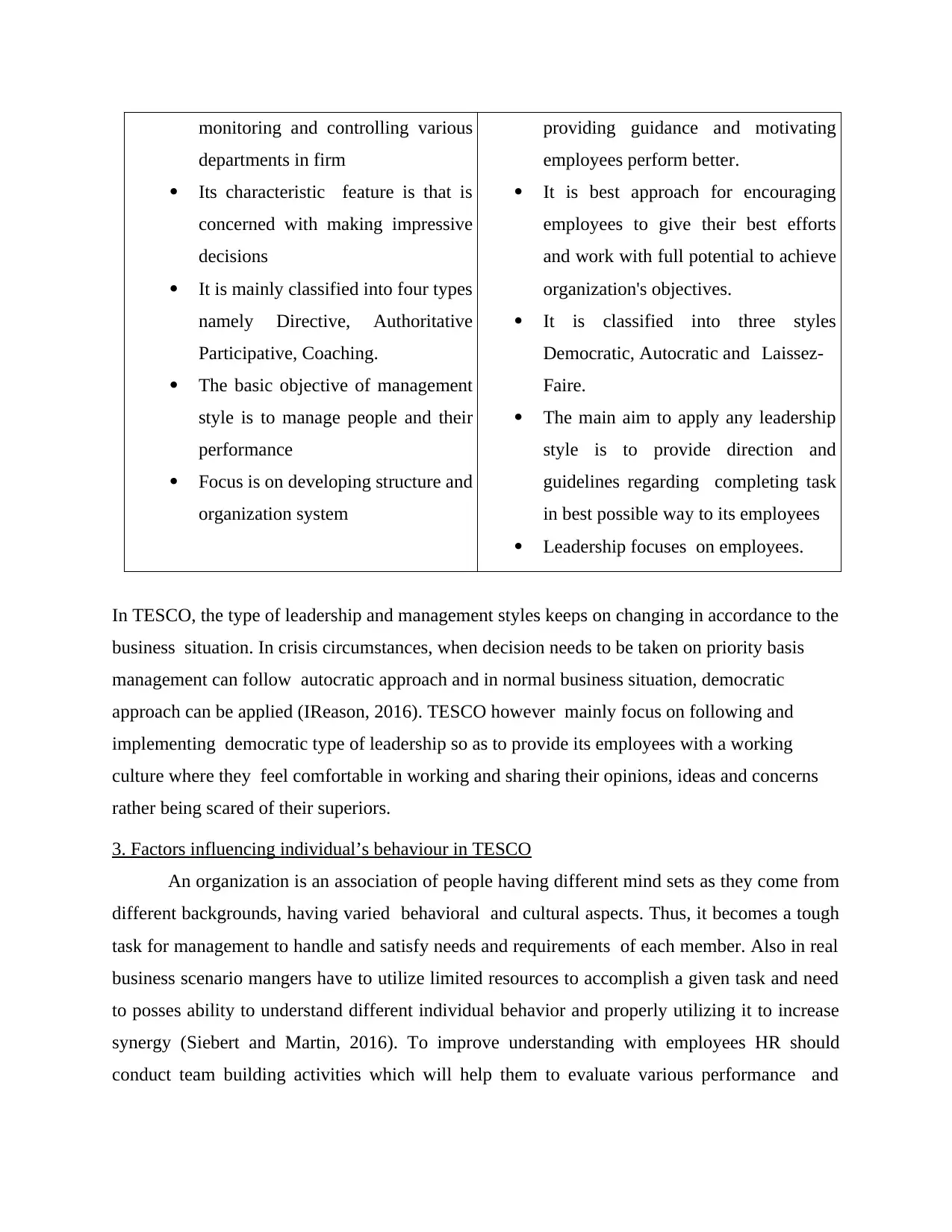
monitoring and controlling various
departments in firm
Its characteristic feature is that is
concerned with making impressive
decisions
It is mainly classified into four types
namely Directive, Authoritative
Participative, Coaching.
The basic objective of management
style is to manage people and their
performance
Focus is on developing structure and
organization system
providing guidance and motivating
employees perform better.
It is best approach for encouraging
employees to give their best efforts
and work with full potential to achieve
organization's objectives.
It is classified into three styles
Democratic, Autocratic and Laissez-
Faire.
The main aim to apply any leadership
style is to provide direction and
guidelines regarding completing task
in best possible way to its employees
Leadership focuses on employees.
In TESCO, the type of leadership and management styles keeps on changing in accordance to the
business situation. In crisis circumstances, when decision needs to be taken on priority basis
management can follow autocratic approach and in normal business situation, democratic
approach can be applied (IReason, 2016). TESCO however mainly focus on following and
implementing democratic type of leadership so as to provide its employees with a working
culture where they feel comfortable in working and sharing their opinions, ideas and concerns
rather being scared of their superiors.
3. Factors influencing individual’s behaviour in TESCO
An organization is an association of people having different mind sets as they come from
different backgrounds, having varied behavioral and cultural aspects. Thus, it becomes a tough
task for management to handle and satisfy needs and requirements of each member. Also in real
business scenario mangers have to utilize limited resources to accomplish a given task and need
to posses ability to understand different individual behavior and properly utilizing it to increase
synergy (Siebert and Martin, 2016). To improve understanding with employees HR should
conduct team building activities which will help them to evaluate various performance and
departments in firm
Its characteristic feature is that is
concerned with making impressive
decisions
It is mainly classified into four types
namely Directive, Authoritative
Participative, Coaching.
The basic objective of management
style is to manage people and their
performance
Focus is on developing structure and
organization system
providing guidance and motivating
employees perform better.
It is best approach for encouraging
employees to give their best efforts
and work with full potential to achieve
organization's objectives.
It is classified into three styles
Democratic, Autocratic and Laissez-
Faire.
The main aim to apply any leadership
style is to provide direction and
guidelines regarding completing task
in best possible way to its employees
Leadership focuses on employees.
In TESCO, the type of leadership and management styles keeps on changing in accordance to the
business situation. In crisis circumstances, when decision needs to be taken on priority basis
management can follow autocratic approach and in normal business situation, democratic
approach can be applied (IReason, 2016). TESCO however mainly focus on following and
implementing democratic type of leadership so as to provide its employees with a working
culture where they feel comfortable in working and sharing their opinions, ideas and concerns
rather being scared of their superiors.
3. Factors influencing individual’s behaviour in TESCO
An organization is an association of people having different mind sets as they come from
different backgrounds, having varied behavioral and cultural aspects. Thus, it becomes a tough
task for management to handle and satisfy needs and requirements of each member. Also in real
business scenario mangers have to utilize limited resources to accomplish a given task and need
to posses ability to understand different individual behavior and properly utilizing it to increase
synergy (Siebert and Martin, 2016). To improve understanding with employees HR should
conduct team building activities which will help them to evaluate various performance and
⊘ This is a preview!⊘
Do you want full access?
Subscribe today to unlock all pages.

Trusted by 1+ million students worldwide
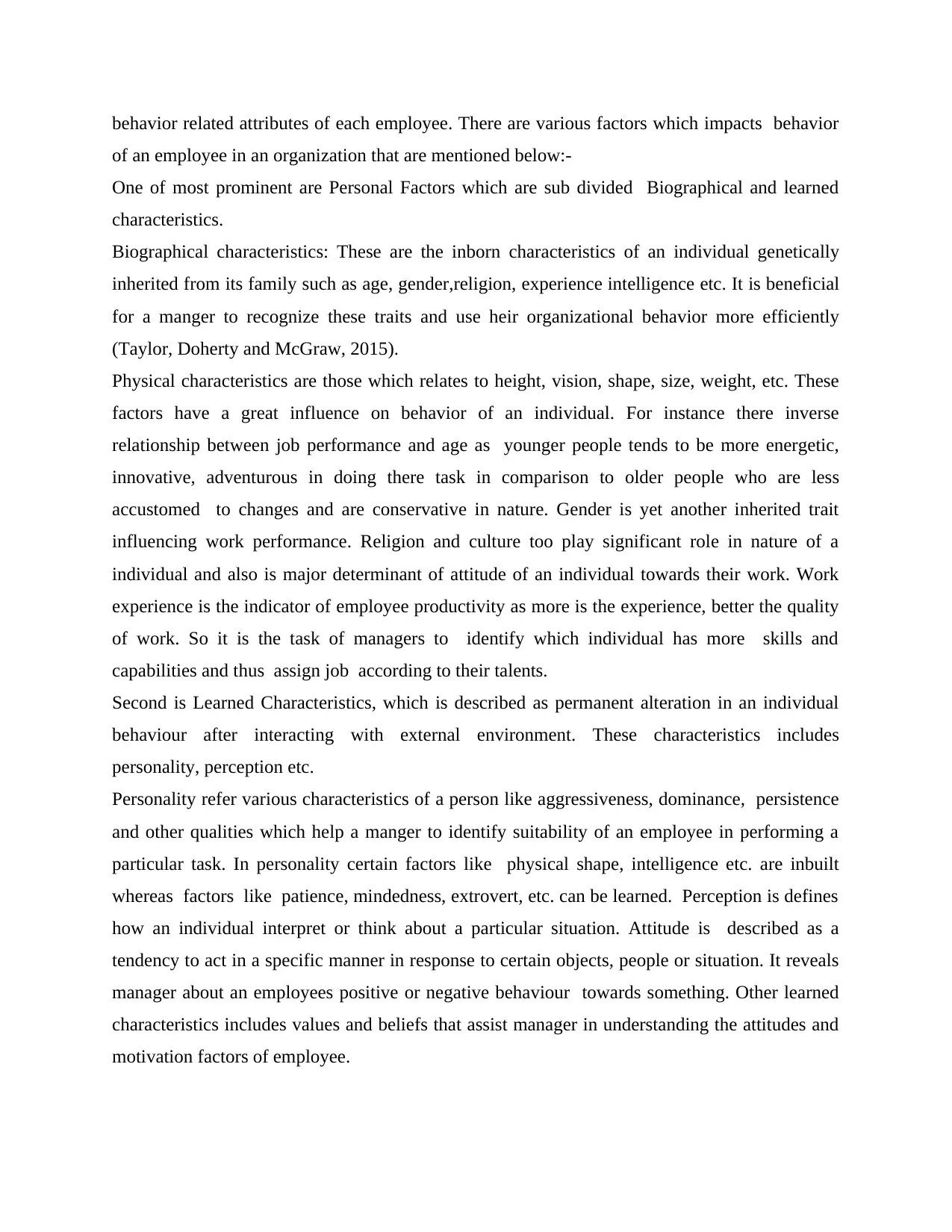
behavior related attributes of each employee. There are various factors which impacts behavior
of an employee in an organization that are mentioned below:-
One of most prominent are Personal Factors which are sub divided Biographical and learned
characteristics.
Biographical characteristics: These are the inborn characteristics of an individual genetically
inherited from its family such as age, gender,religion, experience intelligence etc. It is beneficial
for a manger to recognize these traits and use heir organizational behavior more efficiently
(Taylor, Doherty and McGraw, 2015).
Physical characteristics are those which relates to height, vision, shape, size, weight, etc. These
factors have a great influence on behavior of an individual. For instance there inverse
relationship between job performance and age as younger people tends to be more energetic,
innovative, adventurous in doing there task in comparison to older people who are less
accustomed to changes and are conservative in nature. Gender is yet another inherited trait
influencing work performance. Religion and culture too play significant role in nature of a
individual and also is major determinant of attitude of an individual towards their work. Work
experience is the indicator of employee productivity as more is the experience, better the quality
of work. So it is the task of managers to identify which individual has more skills and
capabilities and thus assign job according to their talents.
Second is Learned Characteristics, which is described as permanent alteration in an individual
behaviour after interacting with external environment. These characteristics includes
personality, perception etc.
Personality refer various characteristics of a person like aggressiveness, dominance, persistence
and other qualities which help a manger to identify suitability of an employee in performing a
particular task. In personality certain factors like physical shape, intelligence etc. are inbuilt
whereas factors like patience, mindedness, extrovert, etc. can be learned. Perception is defines
how an individual interpret or think about a particular situation. Attitude is described as a
tendency to act in a specific manner in response to certain objects, people or situation. It reveals
manager about an employees positive or negative behaviour towards something. Other learned
characteristics includes values and beliefs that assist manager in understanding the attitudes and
motivation factors of employee.
of an employee in an organization that are mentioned below:-
One of most prominent are Personal Factors which are sub divided Biographical and learned
characteristics.
Biographical characteristics: These are the inborn characteristics of an individual genetically
inherited from its family such as age, gender,religion, experience intelligence etc. It is beneficial
for a manger to recognize these traits and use heir organizational behavior more efficiently
(Taylor, Doherty and McGraw, 2015).
Physical characteristics are those which relates to height, vision, shape, size, weight, etc. These
factors have a great influence on behavior of an individual. For instance there inverse
relationship between job performance and age as younger people tends to be more energetic,
innovative, adventurous in doing there task in comparison to older people who are less
accustomed to changes and are conservative in nature. Gender is yet another inherited trait
influencing work performance. Religion and culture too play significant role in nature of a
individual and also is major determinant of attitude of an individual towards their work. Work
experience is the indicator of employee productivity as more is the experience, better the quality
of work. So it is the task of managers to identify which individual has more skills and
capabilities and thus assign job according to their talents.
Second is Learned Characteristics, which is described as permanent alteration in an individual
behaviour after interacting with external environment. These characteristics includes
personality, perception etc.
Personality refer various characteristics of a person like aggressiveness, dominance, persistence
and other qualities which help a manger to identify suitability of an employee in performing a
particular task. In personality certain factors like physical shape, intelligence etc. are inbuilt
whereas factors like patience, mindedness, extrovert, etc. can be learned. Perception is defines
how an individual interpret or think about a particular situation. Attitude is described as a
tendency to act in a specific manner in response to certain objects, people or situation. It reveals
manager about an employees positive or negative behaviour towards something. Other learned
characteristics includes values and beliefs that assist manager in understanding the attitudes and
motivation factors of employee.
Paraphrase This Document
Need a fresh take? Get an instant paraphrase of this document with our AI Paraphraser
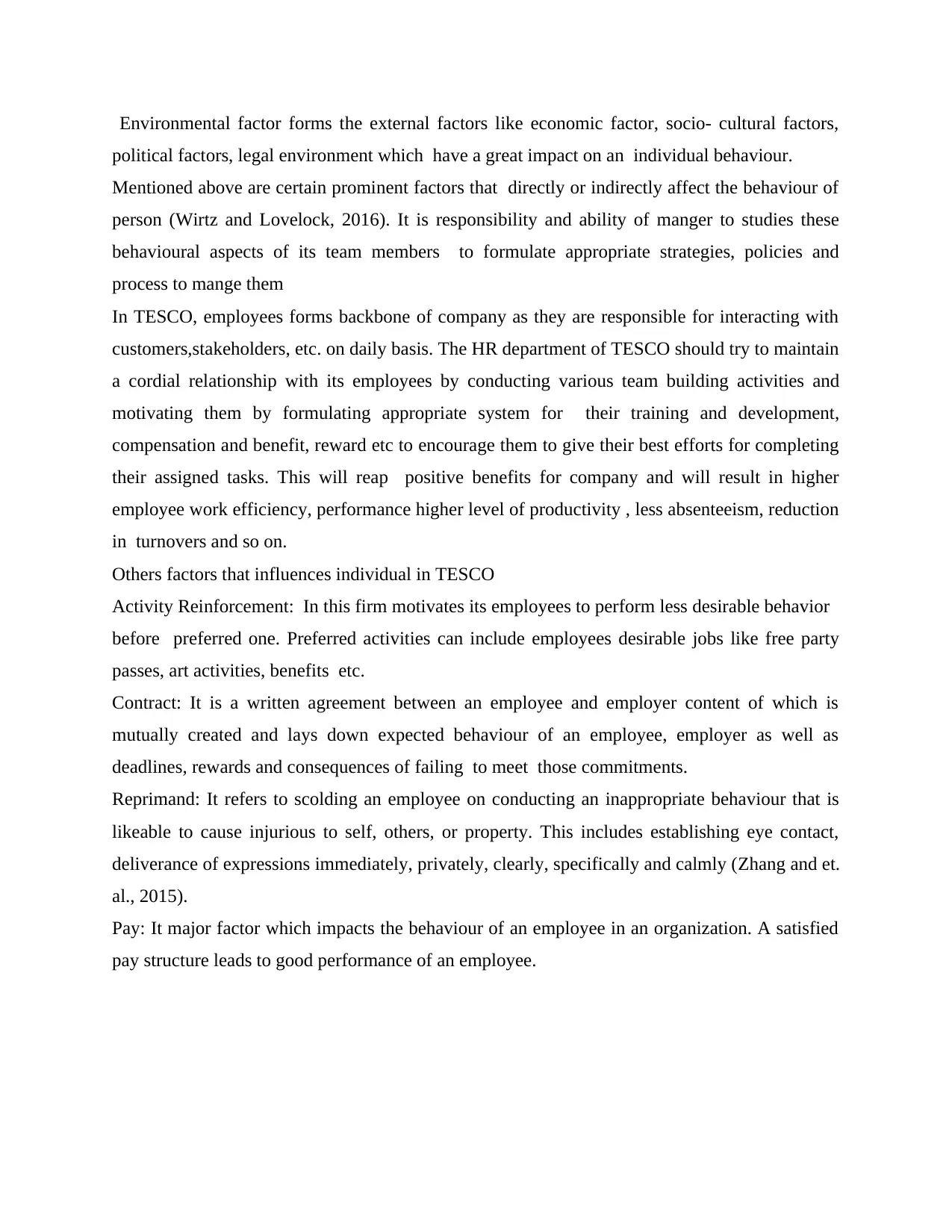
Environmental factor forms the external factors like economic factor, socio- cultural factors,
political factors, legal environment which have a great impact on an individual behaviour.
Mentioned above are certain prominent factors that directly or indirectly affect the behaviour of
person (Wirtz and Lovelock, 2016). It is responsibility and ability of manger to studies these
behavioural aspects of its team members to formulate appropriate strategies, policies and
process to mange them
In TESCO, employees forms backbone of company as they are responsible for interacting with
customers,stakeholders, etc. on daily basis. The HR department of TESCO should try to maintain
a cordial relationship with its employees by conducting various team building activities and
motivating them by formulating appropriate system for their training and development,
compensation and benefit, reward etc to encourage them to give their best efforts for completing
their assigned tasks. This will reap positive benefits for company and will result in higher
employee work efficiency, performance higher level of productivity , less absenteeism, reduction
in turnovers and so on.
Others factors that influences individual in TESCO
Activity Reinforcement: In this firm motivates its employees to perform less desirable behavior
before preferred one. Preferred activities can include employees desirable jobs like free party
passes, art activities, benefits etc.
Contract: It is a written agreement between an employee and employer content of which is
mutually created and lays down expected behaviour of an employee, employer as well as
deadlines, rewards and consequences of failing to meet those commitments.
Reprimand: It refers to scolding an employee on conducting an inappropriate behaviour that is
likeable to cause injurious to self, others, or property. This includes establishing eye contact,
deliverance of expressions immediately, privately, clearly, specifically and calmly (Zhang and et.
al., 2015).
Pay: It major factor which impacts the behaviour of an employee in an organization. A satisfied
pay structure leads to good performance of an employee.
political factors, legal environment which have a great impact on an individual behaviour.
Mentioned above are certain prominent factors that directly or indirectly affect the behaviour of
person (Wirtz and Lovelock, 2016). It is responsibility and ability of manger to studies these
behavioural aspects of its team members to formulate appropriate strategies, policies and
process to mange them
In TESCO, employees forms backbone of company as they are responsible for interacting with
customers,stakeholders, etc. on daily basis. The HR department of TESCO should try to maintain
a cordial relationship with its employees by conducting various team building activities and
motivating them by formulating appropriate system for their training and development,
compensation and benefit, reward etc to encourage them to give their best efforts for completing
their assigned tasks. This will reap positive benefits for company and will result in higher
employee work efficiency, performance higher level of productivity , less absenteeism, reduction
in turnovers and so on.
Others factors that influences individual in TESCO
Activity Reinforcement: In this firm motivates its employees to perform less desirable behavior
before preferred one. Preferred activities can include employees desirable jobs like free party
passes, art activities, benefits etc.
Contract: It is a written agreement between an employee and employer content of which is
mutually created and lays down expected behaviour of an employee, employer as well as
deadlines, rewards and consequences of failing to meet those commitments.
Reprimand: It refers to scolding an employee on conducting an inappropriate behaviour that is
likeable to cause injurious to self, others, or property. This includes establishing eye contact,
deliverance of expressions immediately, privately, clearly, specifically and calmly (Zhang and et.
al., 2015).
Pay: It major factor which impacts the behaviour of an employee in an organization. A satisfied
pay structure leads to good performance of an employee.
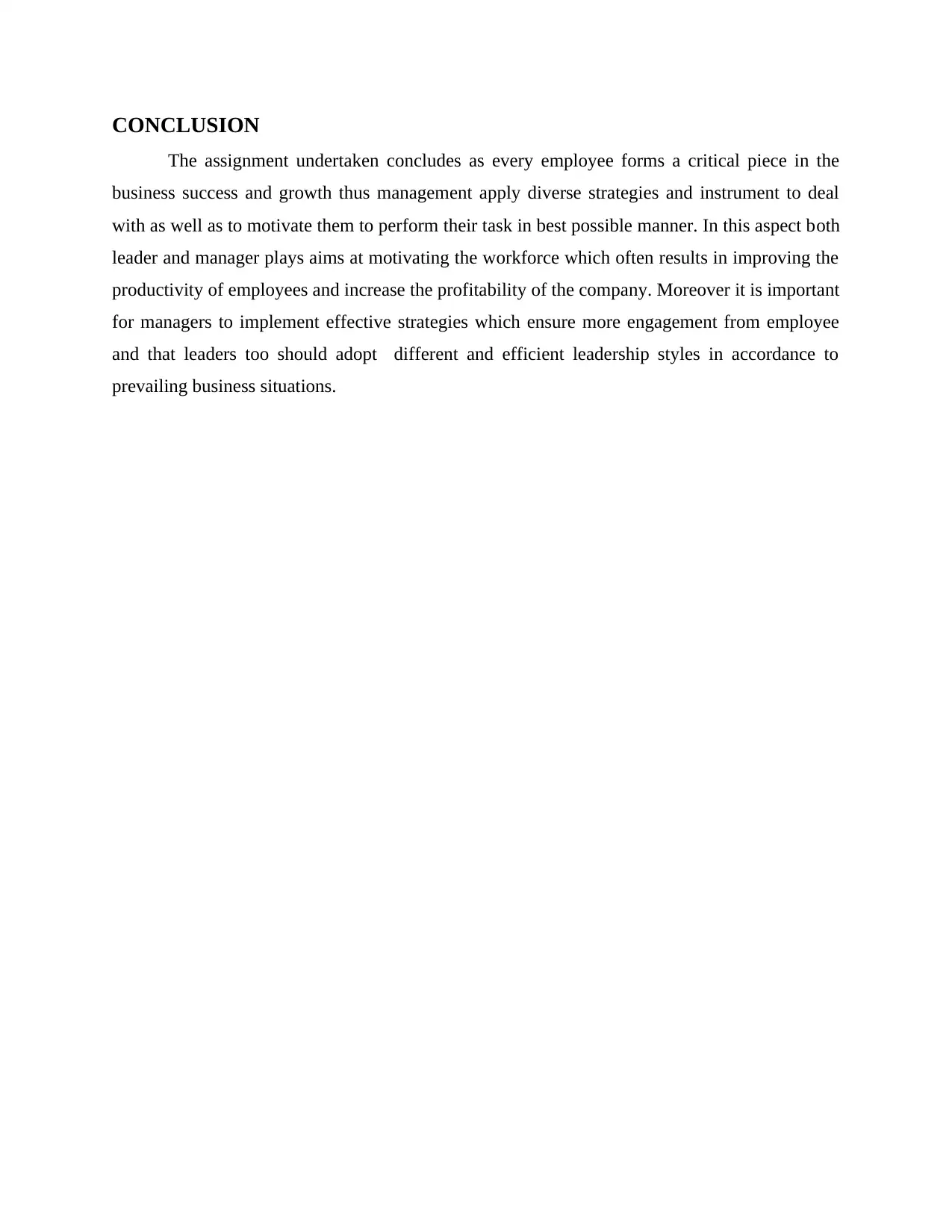
CONCLUSION
The assignment undertaken concludes as every employee forms a critical piece in the
business success and growth thus management apply diverse strategies and instrument to deal
with as well as to motivate them to perform their task in best possible manner. In this aspect both
leader and manager plays aims at motivating the workforce which often results in improving the
productivity of employees and increase the profitability of the company. Moreover it is important
for managers to implement effective strategies which ensure more engagement from employee
and that leaders too should adopt different and efficient leadership styles in accordance to
prevailing business situations.
The assignment undertaken concludes as every employee forms a critical piece in the
business success and growth thus management apply diverse strategies and instrument to deal
with as well as to motivate them to perform their task in best possible manner. In this aspect both
leader and manager plays aims at motivating the workforce which often results in improving the
productivity of employees and increase the profitability of the company. Moreover it is important
for managers to implement effective strategies which ensure more engagement from employee
and that leaders too should adopt different and efficient leadership styles in accordance to
prevailing business situations.
⊘ This is a preview!⊘
Do you want full access?
Subscribe today to unlock all pages.

Trusted by 1+ million students worldwide
1 out of 15
Related Documents
Your All-in-One AI-Powered Toolkit for Academic Success.
+13062052269
info@desklib.com
Available 24*7 on WhatsApp / Email
![[object Object]](/_next/static/media/star-bottom.7253800d.svg)
Unlock your academic potential
Copyright © 2020–2025 A2Z Services. All Rights Reserved. Developed and managed by ZUCOL.



